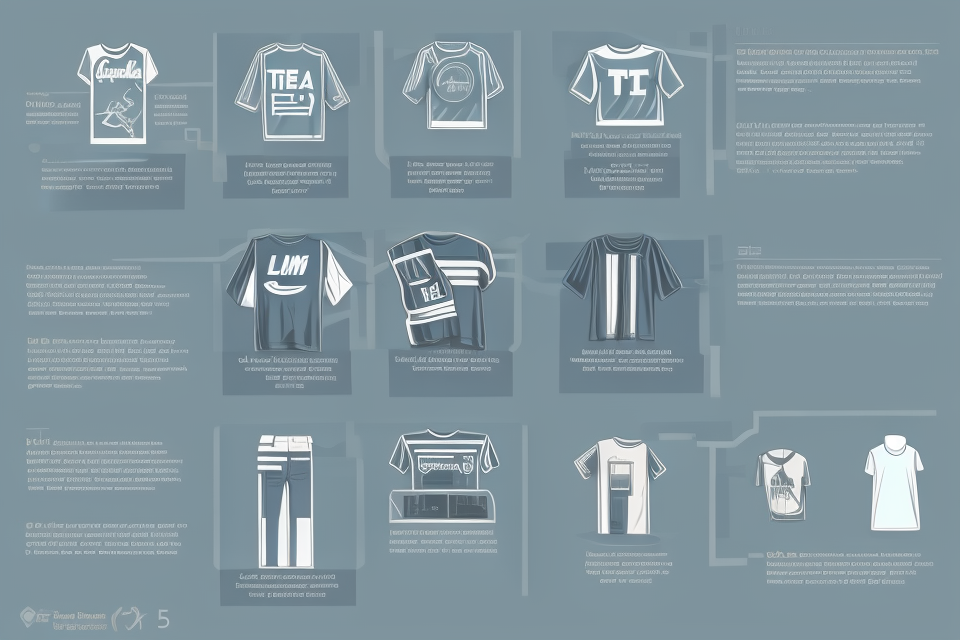The T-shirt is a wardrobe staple that has been a part of our lives for centuries. But have you ever wondered about the origins of the “T” in T-shirt? The simple and humble garment has a rich history that dates back to the 19th century. In this article, we will explore the evolution of the T-shirt and uncover the fascinating story behind the iconic piece of clothing. From its beginnings as a functional undergarment to its rise as a fashion statement, the T-shirt has come a long way. So, let’s dive in and discover the meaning behind the T in T-shirt.
The Evolution of the T-Shirt: From Undergarment to Fashion Statement
The Historical Significance of the T-Shirt
As a Symbol of Social Status
The T-shirt has long been used as a symbol of social status, with certain designs and styles indicating wealth, power, or prestige. For example, in the 1920s, flapper-style T-shirts were popular among the wealthy and fashionable, while in the 1950s, T-shirts with college logos were worn by students who could afford to attend prestigious institutions.
As a Symbol of Identity
T-shirts have also been used as a way to express one’s identity and affiliations. For example, in the 1960s, T-shirts with political slogans or rock band logos became popular among young people who wanted to express their political beliefs or musical tastes. Today, T-shirts with company logos or sports team insignias are commonly worn to show support for a particular brand or team.
As a Symbol of Rebellion
In addition to being a symbol of social status and identity, the T-shirt has also been used as a symbol of rebellion. In the 1950s, T-shirts with provocative slogans or risqué images were popular among those who wanted to challenge societal norms and express their independence. Today, T-shirts with controversial or offensive messages are sometimes worn as a way to make a statement or provoke a reaction.
The Evolution of the T-Shirt Design
- The early 20th century saw the rise of the T-shirt as a popular undergarment for men and women. However, it wasn’t until the mid-century that the T-shirt began to emerge as a fashion statement.
- The 1950s marked a turning point for the T-shirt, with Hollywood films and pop culture icons popularizing the garment as a casual, everyday wear. Marlon Brando’s iconic T-shirt in “A Streetcar Named Desire” helped to cement the T-shirt’s status as a fashion statement.
- In the 1960s, the T-shirt became a symbol of counterculture and youth rebellion, with musicians and political activists sporting the garment as a statement of nonconformity. The T-shirt was worn by the likes of The Beatles, Bob Dylan, and Martin Luther King Jr. as a way to express their political views and personal style.
- The 1970s saw the rise of the graphic T-shirt, with artists and designers experimenting with bold, colorful prints and slogans. The T-shirt became a canvas for political and social commentary, with designs that reflected the era’s major events and issues.
- The 1980s and 1990s saw the T-shirt become a staple of urban fashion, with hip-hop and streetwear culture driving the popularity of the garment. Brands like Nike and Tommy Hilfiger popularized the T-shirt as a fashion statement, with bold logos and graphics becoming a defining feature of the era’s style.
- In the 2000s, the T-shirt continued to evolve as a fashion statement, with the rise of high-end designer T-shirts and limited-edition collaborations. Brands like Supreme and Off-White cemented the T-shirt’s status as a coveted fashion item, with designs that blended streetwear and high-fashion aesthetics.
- Today, the T-shirt remains a ubiquitous garment, with endless variations and styles available to suit every taste and occasion. From basic cotton tees to high-end designer pieces, the T-shirt has come a long way from its humble origins as an undergarment.
The T-Shirt in Popular Culture: From Movie Stars to Political Protests
The T-Shirt as a Fashion Statement
- The T-Shirt as a Form of Self-Expression
The T-Shirt has become a staple of self-expression in popular culture. With the rise of streetwear and casual fashion, people have embraced the T-Shirt as a way to express their individuality and personal style. Whether it’s a graphic tee with a bold design or a basic tee with a unique twist, the T-Shirt has become a canvas for personal expression. - The T-Shirt as a Statement of Style
The T-Shirt has also become a statement of style in popular culture. Celebrities and influencers often wear T-Shirts as a way to make a fashion statement and set trends. Whether it’s a designer T-Shirt with a logo or a vintage T-Shirt with a unique print, the T-Shirt has become a statement piece in many people’s wardrobes. - The T-Shirt as a Symbol of Rebellion
The T-Shirt has also become a symbol of rebellion in popular culture. From punk rock to grunge, the T-Shirt has been used as a way to express dissent and challenge authority. Whether it’s a T-Shirt with a controversial message or a T-Shirt with a bold graphic, the T-Shirt has become a symbol of rebellion and a way to push boundaries.
The T-Shirt in Politics and Social Movements
- The T-Shirt as a Tool for Advocacy
The T-Shirt has become an essential tool for advocacy in political and social movements. It has been used to raise awareness about various causes, from environmental issues to human rights. One of the most iconic examples of this is the “Save the Whales” T-Shirt, which was popularized in the 1970s by environmental activists. The simple yet powerful message on the T-Shirt helped to raise awareness about the plight of whales and inspired many people to take action. - The T-Shirt as a Symbol of Solidarity
In addition to being a tool for advocacy, the T-Shirt has also become a symbol of solidarity in political and social movements. This is particularly true in the case of protests, where people often wear T-Shirts to show their support for a particular cause. For example, during the Civil Rights Movement in the 1960s, many activists wore T-Shirts with slogans such as “Black Power” and “I Am A Man” to show their support for racial equality. - The T-Shirt as a Form of Protest
Finally, the T-Shirt has also become a popular form of protest in political and social movements. In recent years, T-Shirts with provocative messages have been used to challenge powerful institutions and individuals. For example, the “Fuck Trump” T-Shirt became a popular symbol of resistance during the Trump presidency, with many people wearing it as a way to express their dissatisfaction with the administration’s policies. Overall, the T-Shirt has become an important tool for political and social movements, allowing people to express their opinions and advocate for change in a highly visible and impactful way.
The Future of the T-Shirt: Sustainability and Innovation
The Importance of Sustainability in the T-Shirt Industry
Eco-Friendly Materials
In recent years, the fashion industry has faced increasing scrutiny for its environmental impact. To address these concerns, many t-shirt manufacturers are turning to eco-friendly materials, such as organic cotton and bamboo, which require fewer pesticides and less water to grow. Additionally, some companies are exploring alternative materials, such as hemp and recycled polyester, which have a lower carbon footprint and can be recycled multiple times.
Recycling and Upcycling
Recycling and upcycling are becoming more prevalent in the t-shirt industry as a way to reduce waste and conserve resources. By repurposing old t-shirts and turning them into new garments, designers can create unique pieces while also reducing the demand for new materials. Upcycling also allows for the creative reuse of vintage and secondhand t-shirts, which can have a significant impact on reducing the environmental footprint of the fashion industry.
Ethical Production Practices
In addition to environmental concerns, the t-shirt industry is also grappling with ethical production practices. Many manufacturers are now taking steps to ensure that their products are made in safe and fair working conditions, with fair wages and benefits for workers. This includes implementing ethical sourcing policies, conducting regular audits of suppliers, and ensuring that workers’ rights are respected throughout the supply chain.
By prioritizing sustainability and ethical production practices, the t-shirt industry can help to mitigate its environmental impact and improve the lives of workers around the world. As consumers become more conscious of the environmental and social impact of their purchases, sustainable and ethically produced t-shirts are likely to become increasingly popular.
The Future of T-Shirt Design
Smart Textiles
The future of t-shirt design will see the integration of smart textiles, which are fabrics that have been designed to possess unique properties such as the ability to change color, respond to temperature changes, or even generate electricity. These textiles will be woven with tiny sensors and conductive fibers, enabling them to interact with the wearer’s environment and body. This technology will not only enhance the functionality of t-shirts but also pave the way for a new generation of fashion items that can monitor and optimize the wearer’s health, comfort, and performance.
3D Printing
Another innovation that will shape the future of t-shirt design is 3D printing. This technology allows for the creation of complex shapes and designs that were previously impossible to achieve with traditional manufacturing methods. 3D printing will enable designers to create unique, custom-fit t-shirts that are tailored to the individual body shape and size of the wearer. It will also allow for the creation of multi-material t-shirts, where different materials can be combined to create a single garment with varying properties in different areas.
Virtual Reality
Virtual reality (VR) technology will play a significant role in the future of t-shirt design by allowing designers to create and test their designs in a virtual environment before they are produced. This will enable designers to experiment with different shapes, colors, and patterns without the need for physical prototypes, reducing waste and speeding up the design process. VR will also allow consumers to experience and preview their t-shirt designs before they are produced, providing a more personalized and engaging shopping experience.
In conclusion, the future of t-shirt design is an exciting fusion of technology and fashion, where innovative materials, advanced manufacturing methods, and virtual reality will transform the way we create and experience clothing.
The Future of T-Shirt Fashion
-
The Influence of Social Media
Social media has had a significant impact on the fashion industry, including the T-shirt. Platforms like Instagram and TikTok have allowed designers and brands to showcase their products to a wider audience, and hashtags like #tshirtdress and #tshirtsunday have made it easier for consumers to discover new styles and trends.
-
The Influence of Technology
Technology has also played a role in the evolution of the T-shirt. Advances in digital printing and direct-to-garment (DTG) printing have made it possible to produce custom designs and small batches of T-shirts with high-quality results. 3D printing is also being explored as a potential method for creating T-shirts with unique shapes and designs.
-
The Influence of Sustainability
Sustainability is becoming an increasingly important factor in the fashion industry, and the T-shirt is no exception. Many brands are now using eco-friendly materials and production methods, such as organic cotton and recycled polyester, to reduce their environmental impact. Some companies are also exploring alternative business models, such as circular fashion and zero waste, to create a more sustainable future for the T-shirt and the fashion industry as a whole.
FAQs
1. What is the meaning of the T in T-shirt?
The T in T-shirt stands for T-shape, which refers to the design of the garment. The T-shirt is typically a short-sleeved, round-necked shirt with a T-shaped design, featuring short sleeves and a round neckline.
2. What is the history of the T-shirt?
The T-shirt has a long and fascinating history. It originated in the late 19th century as a standard-issue undergarment for U.S. Navy sailors. It wasn’t until the early 20th century that the T-shirt became a popular casual wear item for both men and women.
3. What is the significance of the T-shirt in popular culture?
The T-shirt has become an iconic symbol of popular culture. It has been featured in countless movies, TV shows, and music videos, and has been worn by many famous celebrities and musicians. The T-shirt has also become a popular tool for advertising and promoting products and brands.
4. How has the T-shirt evolved over time?
The T-shirt has undergone many changes over the years. In the early 20th century, it was primarily made of heavy cotton or wool. Today, T-shirts are made from a variety of materials, including cotton, polyester, and spandex, and are available in a wide range of styles, colors, and designs.
5. What is the future of the T-shirt?
The T-shirt is likely to continue to be a popular and enduring fashion item. With the rise of online shopping and fast fashion, the T-shirt is becoming more accessible and affordable for people around the world. Additionally, the T-shirt’s versatility and comfort make it a perfect garment for casual wear in any setting.



